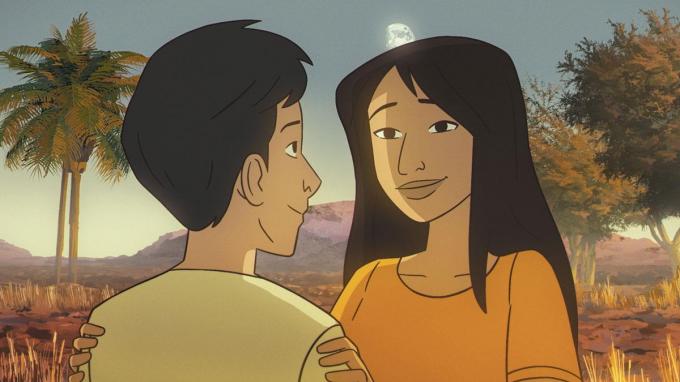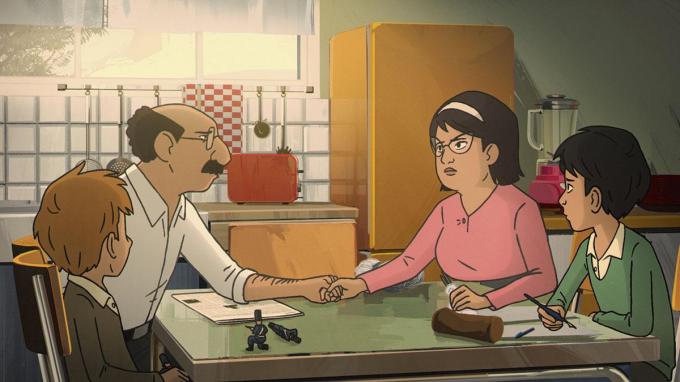My Father’s Secrets transposes the comic strip in which Michel Kichka recounts his relationship with his father, a Holocaust survivor, into an animated film.
With My Father’s Secretsher first animated film, Véra Belmont adapts Michel Kichka’s comic strip, Second generationdedicated to the paradoxical figure of his father, Henri Kichka, victim of the Holocaust and hero by becoming the witness in the eyes of the world of the horror of the camps, while refusing to his children the story of his own journey. The designer tells us about his story, and his transmission through this new adaptation that opens up possibilities.
What made you want to write your comic strip? Second generation?
I have become aware over the years of the importance of the unspoken in my past, of the weight that the Shoah experienced by my father may have had, without him ever telling us about it. As I got older, I began to understand that the family tragedies we had experienced must have had something to do with it. The Shoah was an elephant in the middle of the room that no one saw. Around the age of 50, I felt mature enough to make a comic. I hesitated a lot, because I knew that I would have to reveal truths and that it would not be easy for my father. But I also wanted to tell him that I understood him. That the anger, the frustrations, the revolts were necessary for me, but that I had understood the difficulty for him to come back to life after the camps, to live with the ghosts of the disappeared, while trying to give us joy to live when possible.
How did you react when Véra Belmont proposed to adapt for a young audience this story that you had thought for adults?
I would never have imagined that there could be a “sequel” to my book. But when I met Véra, and saw the way she surrounded herself, I was immediately confident. In writing, she had joined the writer Valérie Zenatti, who translated all the work of the novelist Aharon Appelfeld. And then the film was produced by the animation studio which had adapted Persepolis. I was very moved when reading the script, by the intelligence with which things had been transformed. My story has gained two fantastic things by being brought to the big screen: on the one hand color, sound, music, and on the other hand a wider audience. The way in which the Shoah is shown or rather evoked, whether through my character’s nightmares, or the archives on the Eichmann trial, makes the film become a history lesson, a teaching tool, which my book does not is not. And then the fact that the film is designed to be seen by several people, it is also the opportunity to create dialogue, and to share emotions.

Precisely, the film offers an amplified sounding board to your story, and allows you to continue the dialogue that you opened with your father through writing.
Yes, it’s like a promise that the transmission will continue. This is important, because we know that humanity has a short memory. For the younger generations, the history of the 20th century is prehistory, but it’s my real story, it’s living history. This allows us to visit History in fiction, appealing to other emotions.
Indeed, the film is based on many emotions, with a lot of humor in particular, very present in the relationship between the two brothers, but also with the father, who creates a direct link with the young audience.
Me, I’m a fervent believer in humor, I’m an orthodox of humor! It’s a great way to get people to listen. When you manage to make your audience laugh by talking about serious things, the memory remains. The film plays down, without obscuring reality.
The film evokes the camps, and those who survived them. What do you inherit when your parents survive the camps?
The question is how were we able to live again after the Holocaust? Some came out destroyed, others managed to rebuild. With my father, it was possible when he started to testify. The more he testified, the more he became the man he had always wanted to be. An admired and respected man, after having been dehumanized, having been a number. And then the film also tells another transmission, that of the love of drawing. That too is my spiritual heritage. Finally I realized my father’s dream. Circumstances did not allow him to become a designer, I did. We talk about duty of memory, but what duty, in fact? Valérie Zenatti says that the expression “duty of memory” is very heavy to bear, and that it is not very clear. The film sheds light on this expression. That’s it, the duty of memory, it doesn’t necessarily mean hammering things out, it doesn’t have to be an obligation, and it can go through entertainment and art.
My Father’s Secrets
Seraing, 1959. Michel and Charly, two teasing and endearing brothers do the 400 blows under the loving eye of their mother, and the sometimes stern gaze of their father. It must be said that behind the humorous protrusions, a shadow hangs over the forehead of the patriarch. “Dad is different, he was in the camps”, their mother shouts at them when they dare to ask a question. My Father’s Secrets explores this unsaid, the incommunicability around the Holocaust among survivors, and the scars left in families. Véra Belmont dares to address a young audience around this heavy and painful subject, using a wide range of emotions, careful reconstruction and the power of identification. Through the journey of these two little boys from the 1960s, the film helps to preserve a whole part of the history of the 20th century, by placing itself at child level.

